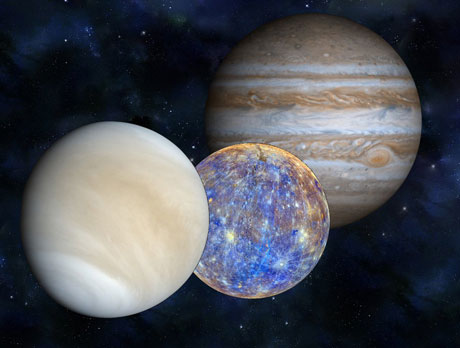Triangle heavenly planets
Tonight Jupiter, Venus and Mercury will form a triangle in the night sky, a scene that people must wait until 2026 to see again.
Venus and Jupiter are the two brightest planets in the solar system. They have come together in the night sky over the past few weeks. Now Mercury, the planet with much lower brightness, is "joining". It is located on the right and below Venus. From the evening of May 24, astronomers can head west to observe the "planet triangle" with the naked eye. Two days later, they will get closer together.

The illustration of Jupiter (Jupiter), Venus (Venus) and Mercury (Mercury) is located west of the sky on the night of May 26. (Photo: National Geographic)
"This is a great opportunity for people to observe the three planets at the same time. The best time to observe that scene is about 30 to 45 minutes after sunset," said Alan MacRobert, an editor. Senior member of Sky & Telescope magazine, said.
On the evening of May 27, we will see Jupiter and Venus staring together in the sky. Jupiter will then begin to move downwards and disappear from sight at the beginning of June. In contrast, Mercury will move above Venus until June 7 before "falling" towards the footpath. Heaven then disappeared. Venus continues to shine strongly in the rest of the year.

Three planets: Jupiter (largest, right), Venus (middle) and Mercury (left). (Photo: National Geographic)
Since Mercury is the closest planet to the sun, humans can only see it an hour before sunrise or after sunset. Under normal conditions, determining Mercury's location is difficult. But in the coming days, its convergence with Jupiter and Venus helps us to locate it more easily.
Although the three planets are quite close together in the night sky, they are in fact far apart in the universe. For example, last week, Mercury is about 169 million kilometers from Earth, while Venus and Jupiter are 241 million kilometers and 909 million kilometers respectively, the Sky & Telescope magazine said.
- The real solution for
- Bermuda Triangle Triangle, where the truth is buried
- Visit the mysterious
- Secretly reveal the Bermuda Triangle Triangle
- Mysterious places like Bermuda Triangle Triangle
- The hidden secret of 165 years of the Bermuda Triangle Triangle has the answer
- New 'Bermuda triangle triangle' appeared?
- Decode the mystery of the
- Dragon Triangle - The waters of many people do not return to Japan
- The 'black cemetery' is more mysterious and frightening than the Bermuda triangle
- Find hidden alien spacecraft under the Bermuda Triangle?
- The mystery of Bermuda Triangle Triangle
 Van Allen's belt and evidence that the Apollo 11 mission to the Moon was myth
Van Allen's belt and evidence that the Apollo 11 mission to the Moon was myth The levels of civilization in the universe (Kardashev scale)
The levels of civilization in the universe (Kardashev scale) Today Mars, the sun and the Earth are aligned
Today Mars, the sun and the Earth are aligned The Amazon owner announced a secret plan to build a space base for thousands of people
The Amazon owner announced a secret plan to build a space base for thousands of people